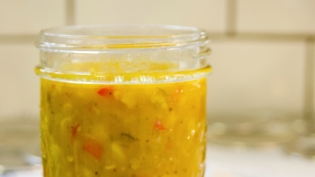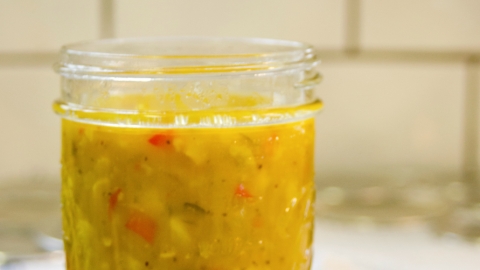The Pickle That Isn't
Would you like some artichoke pickle?
I was asked this by my mother-in-law about ten years ago, and I’m pretty sure I told her no. I didn’t know what she was talking about but in my mind it was some trendy concoction touted by a celebrity chef. Or maybe something you would find at The Olive Garden on an advertised special. Is it a sweet, briny version of canned artichoke hearts? No thank you.
What she produced was a Ball jar of mixed pickle. It was clearly homemade and had a mustard yellow tint that looked like what I would call chow-chow. I back-peddled and got a spoonful for my greens.
Rather than actual artichokes, this artichoke pickle is made from an entirely different plant called a Jerusalem artichoke, which also has no connection to the city of Jerusalem. Some call them sunchokes and they resemble sunflowers from the ground up, which also might explain the origin of their name. Italian immigrants called the plant girasole, Italian for sunflower. Maybe we got to Jerusalem from there.
Under the soil, you will find an edible tuber that is sweet and earthy when compared to a potato. It’s native to the eastern United States and heavily cultivated by the Native Americans, introduced by the French to Europe in 1605. Through the years they have been prepared many ways, as well as fermented into booze, and fed to hogs. I have read that the unique sugar in Jerusalem artichokes causes gastric distress in some, but I have yet to hear of this complaint from eating the pickle.
When I began to appreciate this pickle and incorporate it into my kitchen, I didn’t embrace the name artichoke pickle. It seemed to confuse more than clarify. But then I realized that some folks (mostly old timers from South Carolina) recognized it immediately. It’s still made in home kitchens during the fall and shared with friends over the holidays. In certain circles, people might pass on the traditional tomato aspic or fruitcake or Beaujolais nouveau, but say yes when offered artichoke pickle for their ham biscuit.
Since my introduction I have become an addict and try to always have a jar on hand to add to beans, greens, sandwiches, meats and crackers. I’ve mixed it with mayo to make something like a tartar sauce, and my wife has been known to make a vinaigrette with it. It kind of does everything.
I did a bit of research and found a crude version of artichoke pickle in the cookbook Carolina Housewife, written by Sarah Rutledge in 1837. Linda Ziedrich gets closer to our sauce with her recipe in The Joy of Pickling but that’s where the similarities end. My in-law’s recipe has been passed down for generations from family cookbooks and is similar to others I have tried around the state, but better of course. They call for plenty of Jerusalem artichokes but also add onion, cauliflower and bell peppers. And they chop it all up into almost a relish consistency. I have seen others that leave the artichokes chunky so you can visibly see them in the jar. Our Pop Pop is a big fan of the plastic hand-cranked spinning chopper of “As Seen On TV” fame. He says that if you hand chop, the pieces are too inconsistent and the food processor turns them to mush but three spins around the Chop-o-Matic is about perfect.








